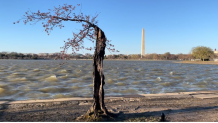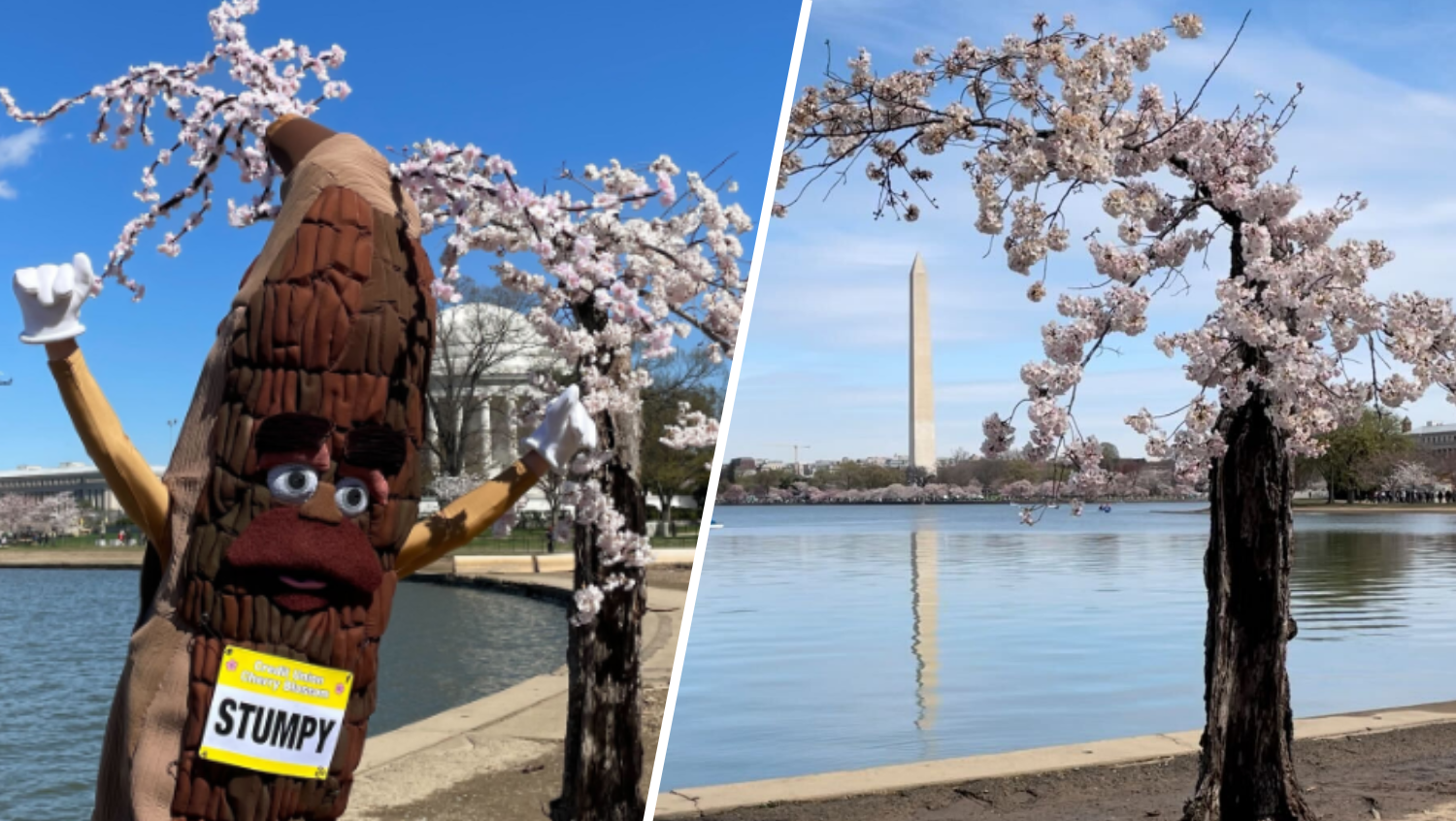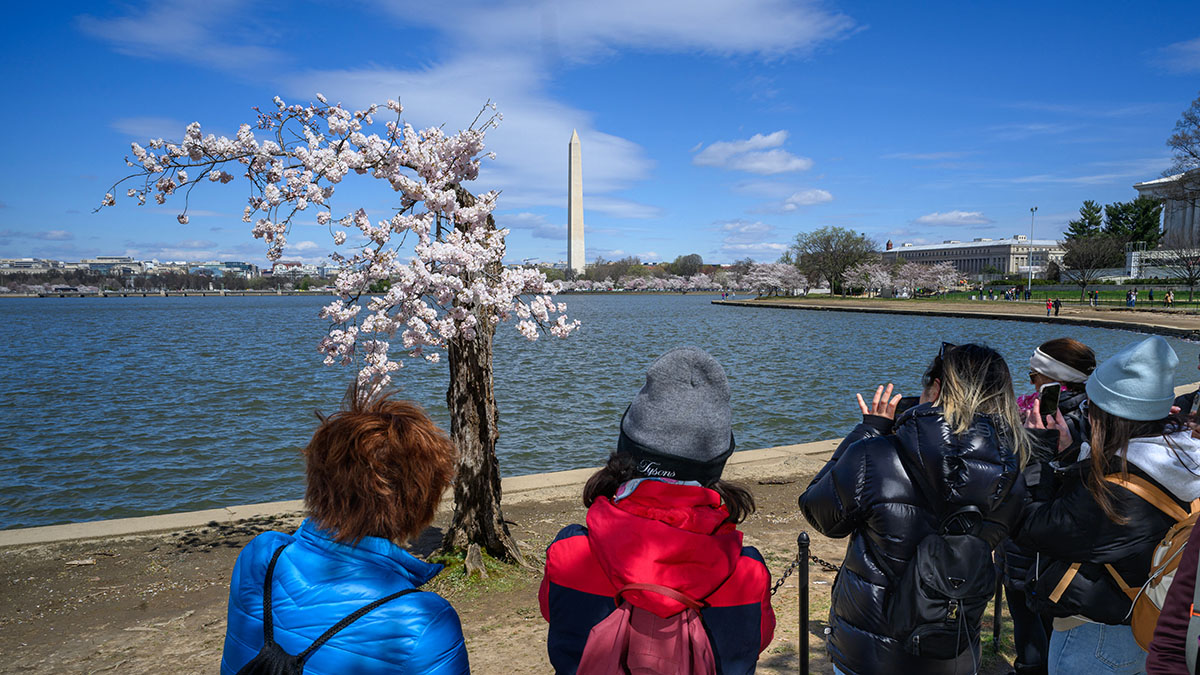In the flood of adjectives used to describe Stumpy during the famous cherry tree's last peak bloom — "hero," "icon," "sensation," "celebrity" and so on — "stubborn" is a word used less often.
But stubborn, Stumpy is. It's the only reason he's lasted this long, given the hostile conditions of his spot on D.C.'s Tidal Basin, according to National Park Service spokesman Mike Litterst. Sometime in May, Stumpy's long fight will finally come to an end. There's nothing the NPS can do at this point to save him.
"If you look to the left around the bend of the Tidal Basin that goes towards the Jefferson Memorial, there are no trees left there," Litterst said. "Because all of those trees that suffered the same inundation of water died, and were removed several years ago."
"Miraculous" is another word that could apply to Stumpy. The gnarled, nearly hollow tree is missing most of its branches, but still has managed to bloom each spring. Litterst says those who call the tree a miracle are "completely correct."
We're making it easier for you to find stories that matter with our new newsletter — The 4Front. Sign up here and get news that is important for you to your inbox.
The whole Tidal Basin has seen increased flooding over the years. The sea level is rising due to climate change, and the seawall, which dates back in the 1800s, has been sinking.
Those are bad conditions all around, but they're worst on that southeast bend, where Stumpy makes his home. During high tides, heavy wind and a full moon, the water between the Jefferson Memorial and the Ohio Drive Bridge has come up over the seawall, covered the sidewalk right next to the water, continued past the grass and covered the sidewalk about 15 feet further inland, Litterst said.
That much water is really bad for plants. Other trees can, and have, died under such conditions.
But not Stumpy.
"Stumpy, despite all of that water, despite his appearance, almost inexplicably still puts out blossoms and blooms every year," Litterst said.
It's why the tree has gotten so much love. The tree has been a poignant symbol for the COVID era: Life goes on, even where and when it doesn't feel like it should. And if Stumpy can survive, maybe we can, too.
So the news that Stumpy would be removed, and eventually mulched, in addition to more than 100 other cherry trees, hit hard. People were upset.
"Damn they can't move him or nothing? Going straight to murder?!" asked one commenter on our Instagram post announcing Stumpy's impending demise.
To save future trees, and possibly pedestrians in the area who would otherwise be walking in slippery, flooded, unsafe conditions, the seawall must be rehabilitated. And for the seawall to be rehabilitated, the trees must go.
But that logic doesn't make it any easier for the passionate "Save Stumpy" movement.
"Why can't they be relocated/replanted?!" asked another commenter.
The answer? Stumpy likely wouldn't survive being transplanted. He's barely hanging on.

He's been barely hanging on since the beginning. According to Litterst, Stumpy is already in what arborists call the "mortality spiral." By the time we found and started to love him in 2020, in part because of how scraggly he looks, there was nothing that could really be done.
"There is so little of that tree left to transplant," Litterst said. "There is no interior trunk. People ask us, 'You know how old that tree is?' There literally aren't any rings for us left to count on the interior of the tree."
Stumpy is running on the fumes of a bark framework, barely transmitting nutrients to the few branches that bloom every spring, "and not much else," Litterst said.
No matter how the story continues, Stumpy as we know him has to die. The tree is doomed by the narrative.
If he stays where he is, the floods will take him out, along with other trees that aren't at risk now, but could be without repairs to the seawall.
If the NPS tries to transplant Stumpy, he could die of "transplant shock," Litterst said. It's a bit like the transplant shock some people experience after an organ donation, he explained. Even if the soil, the nutrients and the sun are compatible with what the tree is used to, the new experience of a different location can be hard on any tree's root system.
And Stumpy is in no condition to be transplanted.
"It is in such a weakened condition that it almost certainly would not be able to be removed from the ground without breaking," Litterst said. "Much less the transplant shock that would be sure to follow."
So, to save the other trees from the flooding, and to spare Stumpy an undignified transplant death, Stumpy must and will be removed, with his brethren, later this spring.
But that's not quite the end of the story.
How Stumpy will be propagated into more cherry trees
Stumpy, like the rest of us, may be mortal. But, also like the rest of us, he will live on in the hearts of those who loved him after he dies. Even better, because he is a tree, the NPS can take other steps to give Stumpy a more concrete kind of life after death.
The NPS is working with the U.S. National Arboretum to turn clippings of Stumpy into more cherry trees that are "genetic matches" — essentially clones — of the original. Those Stumpy 2.0s will eventually be planted near the Tidal Basin and in West Potomac Park, helping to replace the trees that must be removed during the seawall rehabilitation project.
"This is a National Mall icon, a Washington D.C. celebrity, social media sensation, you know, but also a symbol of hope and perseverance," Piper Zettel, horticulturist with the Arboretum, told News4. "So, we are really thrilled to be a part of this project."
The National Arboretum, located in Northeast D.C., serves as a kind of combination public garden, plant gene bank, and research station. The 451-acre facility is home to a wide variety of plant and seed specimens, which the employees work to care for, preserve and breed.
Some of their research is into D.C.'s beloved cherry trees. The arboretum field-tests new hybridized species of cherry trees by literally planting them in fields and curated gardens to see how they fare in real-world conditions. Other cherry trees are clones, grown from clippings taken from the Tidal Basin.
The trees make for another lovely pocket of beautiful blossoms in D.C., far from the National Mall — good if you want a taste of spring without getting swept away in a sea of tourists. But some of the trees carry a more historic status.
"The National Arboretum is a gene bank, and part of our mission is to conserve plant material because of its conservation status or genetic importance, for posterity," Zettel explained. "So, part of that preservation process involves us maintaining replicas of the Tidal Basin cherry trees that were donated to the United States as a gift of friendship from Japan in 1912."
For those who, every peak bloom, idly wonder whether D.C. still has any of the trees that first arrived more than 100 years ago, the answer is yes -- they just live at the National Arboretum.
"We also house them here as genetic backups for the National Park Service and future generations," Zettel said.
Their experience with cherry trees makes the arboretum the perfect partners for the NPS when it comes to Stumpy.
The propagation process starts with clippings that arboretum horticulturists will take from the tree after peak bloom ends.
Zettel demonstrated the cutting-and-rooting process for us, using a baby cherry tree in an arboretum propagation greenhouse.
"What we're looking for is new vegetative growth," Zettel said. "So this is new growth that appears on the tips of the branches in the spring, typically after the tree has concluded its flowering."
The clippings were taken by using garden shears to snip a small cluster of around four leaves from the top of the baby tree. Zettel then clipped the bottom three leaves off of the cluster, leaving a long stem and one leaf. She snipped that leaf in half — to reduce the leaf's surface area and prevent water loss, she explained later in an email — and placed it vertically in a flat full of a special mixture of soilless media and perlite.
When Zettel and her colleagues collect clippings from Stumpy later this spring (which they'll probably do about two or three times, she said), they'll place multiple cuttings in each flat, until they run out of material. Then they'll label each specimen and wait for the clippings to form roots.
"If we were collecting material like this from our grounds or from another location, we would be very careful in how we collect the material because we don't want to harm the tree. We want to make proper pruning cuts, follow proper horticultural practice," she said.
There's not much material to take from Stumpy, but the fact that he's set to get mulched comes with a silver lining for the arboretum scientists trying to propagate him.
"Because Stumpy is slated for removal, and because as you've seen, Stumpy is pretty ... stumpy, and does not have a lot of growth of branches on it .... we'll probably collect as much material as we can," Zettel said.
More material means more chances for Stumpy 2.0s to grow roots and take hold in those flats.
Nature is unpredictable. There's no guarantee the Stumpy clippings will take root at all, in part because he's already struggling. But the arboretum has a few tricks up its sleeves to give each Stumpy 2.0 the best chance.
The first is the propagation greenhouse, which allows horticulturists to control moisture levels, temperature and light to create ideal growing conditions.
Some of the clippings will also be shared with a satellite research station the arboretum has in McMinnville, Tennessee. The D.C. location will prepare each clipping before shipping them out of the DMV, and horticulturists in both locations will try to coax the clippings into new trees.
Different locations, and different clippings, mean many opportunities for success.
The cuttings should take between two and four weeks to root, but they'll stay in the flats for around a year, Zettel said.
"Next spring we’ll pot them into individual pots and care for them in our production facility," Zettel said. "As they grow, we’ll move them into bigger pots."
It will take a few years for the baby Stumpies to grow big enough to be planted in the ground. And the arboretum wants to take extra care with the trees, to give them the best chance of survival.
"They'll go back to the park service when we feel that they're ready, when they've put on enough growth," Zettel said. "When we feel that they're strong enough. We also want to work with the park service, and to make sure that this all checks out with the time frame for the construction project. Because we don't want to give them plants that they're not ready to put in the ground."
That means two to three years before you could visit a Stumpy 2.0 on the National Mall, and two to five years before it might start producing flowers.
"The process takes a long time," Zettel said. "Trees grow very slow. So we need to be patient."
And even when Stumpy 2.0s do grow, although they'll be genetic clones of the original, you might not recognize them.
Stumpy is, well, stumpy because of his daily inundation of brackish water. It gave him the shape we all know and love, but it's not good for him. And the goal of the NPS' seawall reconstruction and the National Arboretum propagation project is to create "ideal environmental conditions for the new trees that are planted," Zettel said.
So, because the new trees will be healthy and happy, without "the same life experiences that have shaped Stumpy," they won't have Stumpy's "unique form," Zettel said.
Stumpy, as we know him, is a fleeting phenomenon. He was a warning, which the NPS heeded when they decided to rehabilitate the seawall. When he comes back, he'll come back different and in many forms.
But Stumpy is special because he is impermanent — like the blossoms he produces, as the National Arboretum notes in the booklet for its self-guided flowering cherry tree tour.
"Sakura (cherry blossoms) appear in Japanese myth, poetry, and other art, and their brief blooming has long symbolized a short life lived well," the booklet reads.
Litterst has seen a number of D.C. oddities come and go. But Stumpy, and the love he's inspired?
"I've never seen anything like it."




